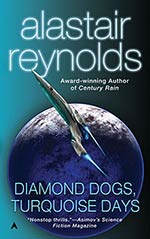
![]() Nymeria
Nymeria
6/10/2016
![]()
In my search for some swift read between more consistent books I encountered this small anthology from Alastair Reynolds, one of my favorite SF authors: it consists of only two novellas, Diamond Dogs and Turquoise Days, and besides being exactly what I was looking for, it adds a few interesting details about the universe where Reynolds grounds his novels, and some of the races or events described there. The first one in particular, Diamond Dogs, was a swift and compelling read, the kind of story that starts in a deceptively offhand way, only to gain momentum and take firm hold of one's imagination, catching the reader completely by surprise.
On the outward, it looks like a cross between a quest and a heist: on the remote and desolate planet Golgotha there's a strange construct, clearly artificial -- it's a spire that dominates the bleak plains of the inhospitable world, a huge artifact of unknown origins that probably holds fascinating secrets, or riches. Or both. The unfortunate spacers who first found it discovered that to progress inside the spire one had to solve increasingly difficult mathematical problems, failure to provide the correct answer resulting in maiming and death: Roland Childe, the expedition's coordinator, has learned that much from the last survivor before the man's death, so he returns to Golgotha with a team of people highly suited to face the spire's challenges.
The story develops with an apparently repetitive cycle of actions -- the solving of puzzles, the progress through the rooms, an encounter with a difficult problem or a particularly debilitating "punishment" that forces the group to go back to their ship and focus on a new strategy before again returning to the Spire -- and yet it's never boring or predictable, mostly because Reynolds manages to infuse it with a sense of impending danger through the subliminal perception of a watching, waiting entity that's lying in ambush for the slightest mistake, so that it can discourage the explorers in the goriest way possible. The Bloody Spire -- as the group comes to call the artifact -- is clearly a mechanical construct, but the way it seems to adapt to the choices of the people moving through its rooms, the way it seems to tailor its own actions on the responses of the individuals, points at intelligence and awareness, and that's what makes it scary, even though one realizes it's artificial -- or maybe exactly because of that.
What's even more chilling, though, is the growing obsession shown by the adventurers: unfazed by the grisly remains scattered around the Spire, silent witnesses of failed previous attempts, they seem to take every escalation of the difficulties as a personal affront, and are ready to take extreme measures to insure their own mental and physical preparedness for the challenges still to come. First it's nanotechnology to increase their brains' computational and logical skills, then it's body modification for both protection against the vicious assaults and the ever-increasing difficulty in navigating the various rooms. It's this last element, the progressive de-humanization of the characters, merged with their refusal to accept defeat -- or to acknowledge the law of diminishing returns -- that gives this story a bleak flavor, that remains fascinating until the bitter end. This is Reynolds at his best, indeed.
Turquoise Days creates a very different mood, its slow pace making it feel almost anti-climatic if compared with the other story: in the oceanic world of Turquoise dwell the mysterious Pattern Jugglers, shapeless group organisms that can store the consciousness of every swimmer who ever treaded their waters, and even subsume some of those swimmers, forever preserving their memories and knowledge. The Jugglers have often figured in Alastair Reynold's novels, but more as a passing mention than a deeply explored race, so this story gave me a fascinating insight into what they are by following the studies of two sisters, Naqi and Mina, who float over Turquoise's oceans on their airship collecting data. This novella's buildup is quite leisurely and I was not as taken with it as with the previous one, until the point, that is, when an unusual event like the arrival of a spaceship with visiting delegates breaks the world's quiet routine and rapidly turns into drama. The events move then at breakneck speed, and I could empathize with Mina and her reaction at the sudden implosion of the life she had built for herself, but even more with her fear for the destruction of Turquoise's eco-system: there is a very poignant reason for her fierce response to the threat, the same reason that brings her to her ultimate choice at the very end. If I had, until that moment, followed the story with something approaching inertia, I became quite invested in what was happening, and felt a strong emotional reaction at the way the events unfolded.
A different kind of tale, but just as involving as the first one.
http://spaceandsorcery.wordpress.com